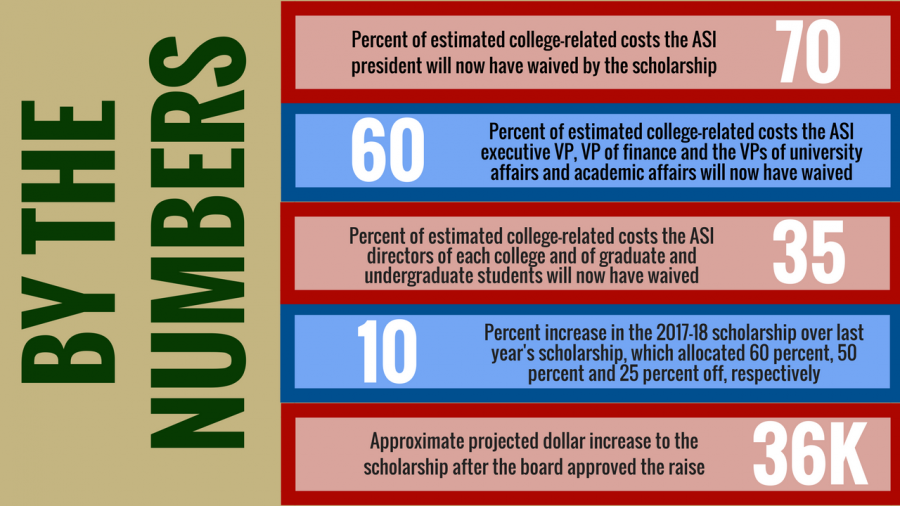At its April 12 meeting, the Sacramento State Associated Students, Inc. Board of Directors voted to increase the scholarship given to its elected members by 10 percent starting in the 2017-18 school year — resulting in an overall projected $35,709 increase.
Vice President of Academic Affairs Abraham Mendoza III said at the meeting that while he knows some people will “raise their eyebrows” at the increase, there needs to be adequate support for the time each board member spends on their ASI duties — specified and unspecified.
“I understand we don’t want to be too gung ho about things, but still recognize what is fair compensation,” Mendoza said.
According to the board’s operating rules, the ASI president currently receives funding for 60 percent of their “estimated cost of attendance for living off campus as published by the Sacramento State Financial Aid Office.”
The executive vice president, vice president of finance and vice presidents of university affairs and academic affairs receive 50 percent, and the directors of each college, and the directors of undeclared and graduate students receive 25 percent.
Board associate Lisa Dalton assured that the extra funding for the board members’ scholarships will not come out of the pockets of students — either in the form of a raise in fees or tuition — or the reduction in funding to other programs. Instead, it would result from an increase to the 2017-18 budget, which was also approved later in that meeting.
Next year’s budget has also been passed to operate at a deficit of $348,426, but the $9,523,820 budget won’t be finalized until the university president signs off on it, said ASI Director of Finance and Administration Mark Montalvo.
However, ASI Executive Director Pat Worley said that just because a deficit is projected doesn’t mean the board will end up with one at the end of the fiscal year, which runs from July 1 to June 30.
For example, when the 2015-16 budget was passed, it was projected that ASI would operate at a net loss of $147,855. But when the school year ended, the independent auditor’s report indicated that the board was left with a $925,739 surplus, otherwise known as “a change in net assets.”
“If funds are not fully spent in the budget, then in most cases the funds go into surplus accounts,” Montalvo said. “If funds have been designated for a particular event or category, then the funds are set aside for that purpose.”
Worley said the 2016-17 budget is currently running below the forecasted shortfall of $346,889, but explained that the operating surplus is intended to provide a buffer in the event that a new board begins its term at a deficit.
Surpluses can result from a low estimation of projected enrollment numbers from the university — students pay a mandatory ASI fee every year — administrators’ frugality practices and higher than expected revenue from ASI programs such as Peak Adventures and the Aquatic and child care centers, said Worley, which the student government has a history of seeing.
“(It is) partially (what) gave the board some confidence in raising the board scholarship,” Worley said.
The current board’s scholarships have already been handed out, with the awards being delivered in two disbursements — one at the beginning of each semester — and every other year a scholarship review committee is formed to advise the board on whether to make changes that will go into effect in the following school year’s budget.
But the operating rules do stipulate that any members who intend to return to the board cannot be a part of the special committee.
One reason for the raise which was discussed during the meeting was the idea that board members tend to go above and beyond the specified duties set for them in the operating rules, which can make holding down a job on top of taking classes a difficult feat.
While they “work very hard,” Dalton pointed out that what the board members do is not an actual job with set scheduled hours resulting in a paycheck — they are volunteers who receive a scholarship.
“There are task forces, there are search committees, there are all these different things that are not necessarily direct responsibilities but are indirectly expected of us as student leaders and representatives,” Mendoza said at the meeting. “I felt that if for those of us to just stick solely based on what our operating rules imply and specify, a lot of the work that keeps this organization working and representing students would fall by the wayside — easily.”
Some of the members did have concerns with the increase in regard to future board members not working as hard to deserve the extra funding or how ASI might be able to enforce accountability for those who would take the money and run, which ASI President Patrick Dorsey said has happened in the past. Ultimately the board decided those type of things could be discussed at a later date.
Mia Kagianas, the 2017-18 ASI president-elect and current director of business administration, who abstained from the vote, said that during her first term on the board last year, she struggled financially and felt her position and the students she was representing suffered because she was working two jobs while taking that position with a 15-unit course load, and didn’t want similar issues to deter others from running for office.
“I want to make this approachable for all students, regardless of their financial obligations — if they have to work several jobs or whatever it may be,” Kagianas said. “If they want to get involved, we want to make this a very accessible environment and opportunity for all students.”































































































































